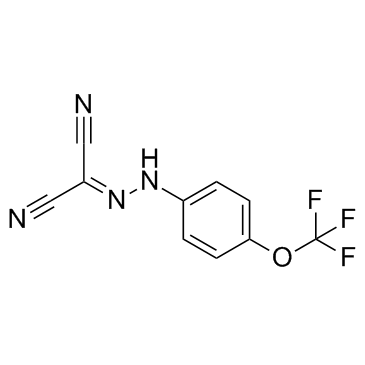FCCP

FCCP structure
|
Common Name | FCCP | ||
|---|---|---|---|---|
| CAS Number | 370-86-5 | Molecular Weight | 254.168 | |
| Density | 1.3±0.1 g/cm3 | Boiling Point | 293.3±50.0 °C at 760 mmHg | |
| Molecular Formula | C10H5F3N4O | Melting Point | 174-175ºC (dec.)(lit.) | |
| MSDS | Chinese USA | Flash Point | 131.2±30.1 °C | |
| Symbol |

GHS06 |
Signal Word | Danger | |
Use of FCCPFCCP is an uncoupler of oxidative phosphorylation in mitochondria. |
| Name | carbonyl cyanide p-trifluoromethoxyphenylhydrazone |
|---|---|
| Synonym | More Synonyms |
| Description | FCCP is an uncoupler of oxidative phosphorylation in mitochondria. |
|---|---|
| Related Catalog | |
| In Vitro | FCCP (5 μM) results in a concentration-dependent decrease in Aβ and APPsβ production in K695sw cells. FCCP inhibits processing of wild-type APP. FCCP does not alter cellular ATP levels at any of the concentrations measured. The effects of FCCP on APP catabolism are independent of secondary effects on oxidative phosphorylation or the result of reduced cell viability. FCCP (5 μM or 500 nM), baf A1, and NH4Cl induce changes in Tf-Tx and Tf-F cellular fluorescence in K695 cells[1]. FCCP (200 nM) protects and enhances the follicle integrity in cat ovarian tissue during short-term in vitro culture. But FCCP does not appear to exert a beneficial or detrimental effect during ovarian tissue cryopreservation[2]. |
| Cell Assay | K695sw cells are maintained and exposed to vehicle or various concentrations of FCCP as mentioned above with the exception that cells are plated at a density of 20,000 cells per well in 96-well plates. Twenty-four hours after plating, cells are exposed to various treatments in Dulbecco’s modified Eagle’s medium supplemented with sodium pyruvate (1 mM). At the same time as drug exposures, YO-PRO (4 μM) is added to each well, and its uptake is quantified every 30 min for 1 day at 37°C using a Cytofluor 2350 fluorometric plate reader. As a positive control, all wells are exposed to 0.1% Triton X-100 at the end of the experiment[1]. |
| References |
| Density | 1.3±0.1 g/cm3 |
|---|---|
| Boiling Point | 293.3±50.0 °C at 760 mmHg |
| Melting Point | 174-175ºC (dec.)(lit.) |
| Molecular Formula | C10H5F3N4O |
| Molecular Weight | 254.168 |
| Flash Point | 131.2±30.1 °C |
| Exact Mass | 254.041550 |
| PSA | 81.20000 |
| LogP | 3.65 |
| Vapour Pressure | 0.0±0.6 mmHg at 25°C |
| Index of Refraction | 1.522 |
| Storage condition | 2-8°C |
| Water Solubility | acetone: 20 mg/mL, clear, very deep greenish yellow |
| Symbol |

GHS06 |
|---|---|
| Signal Word | Danger |
| Hazard Statements | H301-H317-H413 |
| Precautionary Statements | P280-P301 + P310 |
| Personal Protective Equipment | Eyeshields;Faceshields;Gloves;type P2 (EN 143) respirator cartridges |
| Hazard Codes | T: Toxic;Xi: Irritant; |
| Risk Phrases | R25 |
| Safety Phrases | 36/37-45 |
| RIDADR | UN 2811 6 |
| WGK Germany | 3 |
| RTECS | FG5775000 |
| Packaging Group | II |
| Hazard Class | 6.1(a) |
| HS Code | 2928000090 |
| Precursor 2 | |
|---|---|
| DownStream 0 | |
| HS Code | 2928000090 |
|---|---|
| Summary | 2928000090 other organic derivatives of hydrazine or of hydroxylamine VAT:17.0% Tax rebate rate:9.0% Supervision conditions:none MFN tariff:6.5% General tariff:20.0% |
|
Muscle-specific Drp1 overexpression impairs skeletal muscle growth via translational attenuation.
Cell Death Dis. 6 , e1663, (2015) Mitochondrial fission and fusion are essential processes in the maintenance of the skeletal muscle function. The contribution of these processes to muscle development has not been properly investigate... |
|
|
HC toxin (a HDAC inhibitor) enhances IRS1-Akt signalling and metabolism in mouse myotubes.
J. Mol. Endocrinol. 55 , 197-207, (2015) Exercise enhances numerous signalling pathways and activates substrate metabolism in skeletal muscle. Small molecule compounds that activate these cellular responses have been shown to recapitulate th... |
|
|
NH2-truncated human tau induces deregulated mitophagy in neurons by aberrant recruitment of Parkin and UCHL-1: implications in Alzheimer's disease.
Hum. Mol. Genet. 24 , 3058-81, (2015) Disarrangement in functions and quality control of mitochondria at synapses are early events in Alzheimer's disease (AD) pathobiology. We reported that a 20-22 kDa NH2-tau fragment mapping between 26 ... |
| 2-{2-[4-(trifluoromethoxy)phenyl]hydrazono}malononitrile |
| 2-[[4-(trifluoromethoxy)phenyl]hydrazinylidene]propanedinitrile |
| Propanedinitrile, 2-[2-[4-(trifluoromethoxy)phenyl]hydrazinylidene]- |
| FCCP,Mesoxalonitrile 4-trifluoromethoxyphenylhydrazone |
| Carbonyl cyanide 4-(trifluoromethoxy)phenylhydrazone |
| Carbonyl Cyanide p-Trifluoromethoxyphenylhydrazone |
| {2-[4-(trifluoromethoxy)phenyl]hydrazinylidene}propanedinitrile |
| EINECS 206-730-8 |
| {[4-(Trifluoromethoxy)phenyl]hydrazono}malononitrile |
| MFCD00009699 |
| FCCP |
 CAS#:461-82-5
CAS#:461-82-5 CAS#:109-77-3
CAS#:109-77-3